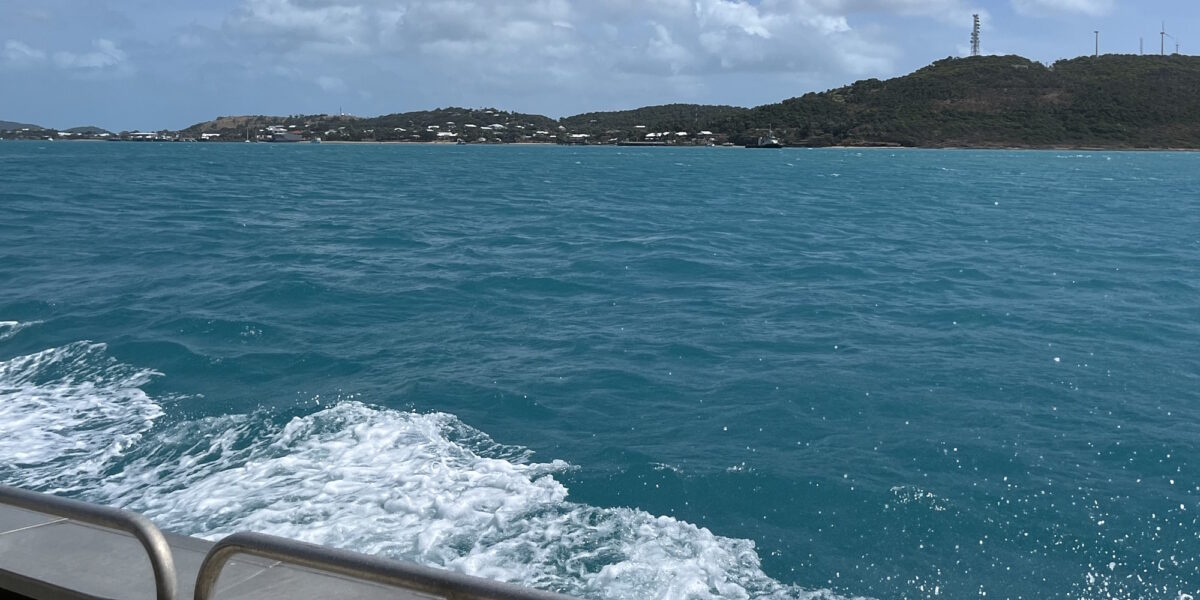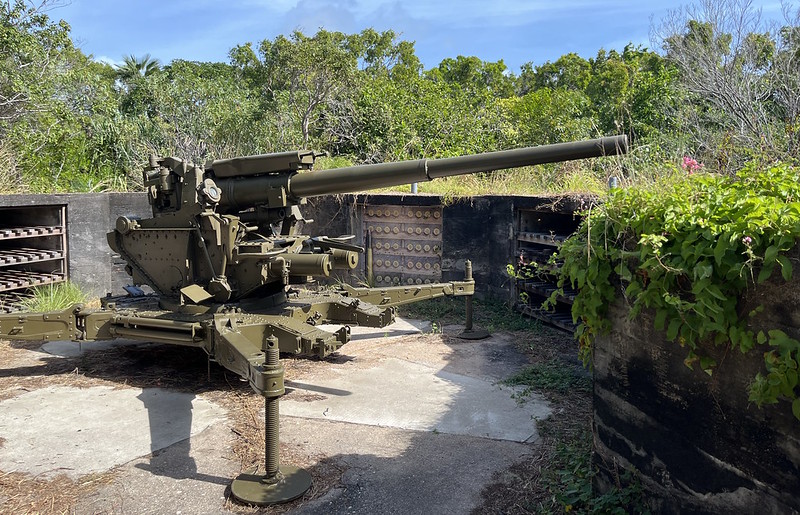We were holed up in our accommodation on Thursday Island. No sleep-in for us; we received a delivery of locally produced “breakfast boxes” at 7am.
This was actually a great start to the day, a great mix of yummy stuff to eat for breakfast or save for later, and an hour later we were boarding a minibus driven by Liberty, another local guide. Today we’d be seeing two islands.
First we went back to TI’s Green Hill Fort, but this time with access into the museum there to browse around. Inside there’s some interesting stuff, mostly WW2 history.
A copy of the Torres Strait Pilot from 27 January 1942 includes various war news on the front page (which was usually the only page), then right at the bottom next to an ad for gin, an article mentioning that oh yes by the way all women and children are to be compulsorily evacuated from Thursday Island.
WW2 had an enormous impact on our family. Having lived on TI for decades, most of the family evacuated ahead of the mandatory order, in December 1941, with our grandfather leaving several weeks later.
They never returned (until we made this trip), and we discovered this was the same for many families. Some eventually came back (including our guide’s family), but most didn’t.
After the Fort, our minibus rolled through the cemetery, pausing at the grave of Bernard Namok, who designed the Torres Strait flag. We’d already heard a bit about it, and there seems to be a consensus that it’s a good design:
- the star represents peace, the five major island groups, and the importance of the stars for sea navigation
- green stripes represent the land
- black stripes represent the people
- blue represents the sea
- and of course there’s the distinctive Dhari headdress
The Torres Strait flag is of course one of Australia’s three official flags.
After a drive around and a quick look at a few other sites, the minibus dropped us back at our accommodation for a morning tea break.
A little later we headed down to the wharf to catch a ferry to Horn Island, for the second part of the tour.
We walked from the wharf to the Torres Strait Heritage Museum, showing some more of the indigenous and post-white-settlement history.
It seems the original inhabitants were of Melanesian descent, travelling down from what is now Indonesia and PNG, when all the land was connected. For centuries there was interaction and trading with those to the north in PNG, and the south on mainland Australia.
Also of interest were 19th and 20th century photos of TI showing Douglas Street at various times. We were starting to get a picture of where the family store may have been, a task not made easier by the lack of street numbers at the time.
We boarded a minibus… Wait, was it the same minibus, we asked our guide Liberty? “No!” he said – it costs about $2500 to move vehicles between the islands, so he has one on Horn Island and one on Thursday Island.
After a stop at a WW2 site or two (more about some of these later), we ended up at the Wongai pub, where the chips came highly recommended. And excellent they were too.
The alien
Over lunch we were also getting info coming through email about family research done by Liberty’s wife Vanessa, which had some good information. Some of it confirmed what we knew already; other items nicely supplemented it.
One surprise: Australian authorities interviewed my grandmother Gertrude in 1942, presumably trying to figure out if she was a spy. She’s referred in the paperwork as an alien, and her nationality as Chinese, even though she was born in Townsville.
The forms also appear to assume the person of interest is male, and has just arrived, rather than lived here for 50 years, so there’s a lot of “NA” responses entered by the investigators.
The responses in the form concluded she had no firearms, nor a radio set, nor was she a member of the Nazi Party or any other fascist organisation, and that “reliable neighbours” considered her of good character.
The conclusion? “Alien appears to be of good character, and no action required to restrict movements.” So that’s good.
And: “This lady was a British subject before she was married.” – the equivalent of citizenship before 1949, apparently. Dual citizenship wasn’t fully a thing until 2002!
With lunch and the interrogations completed, our group of alien descendants hopped back on the bus to get a look at some WW2 sites.
Horn Island and WW2
Thursday Island was evacuated during WW2, but ultimately was never actually bombed by the Japanese. One theory is they thought too many of their own countrymen were on TI; another was the presence of Japanese graves in the cemetery there.
Horn Island was not spared – unsurprising as RAAF had built an airbase, and runways were built there during the early months of the war. These runways became the airport of today.
The island was bombed numerous times – apparently only second after Darwin. This page goes into more detail of the various enemy raids.
Horn Island was also the site of several military air crashes.
The allied forces would hide parked aircraft with foliage, and anti-aircraft guns were located around the island.
There are also some pretty big ant hills to observe on the island, though we would see even larger ones in coming days.
Here’s a sign you don’t see down south. You don’t want to attract crocs!
Back on Thursday Island
We caught the ferry back to TI, and I took an afternoon stroll to the supermarket to pick up some supplies, and also found the servo. Petrol was $2.70 a litre… but then, there’s not very far you can drive, so most people probably don’t fill up very often.
And I found a bus stop. There are a few scattered around the island. As far as I can tell, there’s technically no public transport, but there are school buses, which is what these bus stops are for. This one is opposite the Catholic school.
We all thought we’d had too much food today, so it was ham and cheese toasties for dinner – just the thing.
One more full day on TI tomorrow, and we had a couple of mysteries to try and solve.










4 replies on “History, old and new”
Absolutely fascinating. Not many mainland Australians expecially those in the southern states can say they have been to TI. I visited way back in 1986 on a school geography trip when I was 16. It’s certainly unique and one of my memories was how many taxis the place seemed to have. We were made to feel very welcome. One of my siblings is on her way to TI as we speak. She’s not flying. In an organised tour she’s riding her mountain bike from Coen all the way to Cape York. She’s then getting on a charter boat from Seisia to Thursday Island. Certainly a different way of getting there!
Wasn’t that change to having dual citizenship the ‘Murdoch’ law, so that Rupert could remain Australian and buy into American media as a US citizen?
@Andrew Purvis, wow – that would be some trip on a mountain bike!
@Andrew Cee, according to Wikipedia, Murdoch took US citizenship in 1985, and lost his Australian citizenship as a result. Not sure if he got it back after the law change.
Prior to 1946 if an Australian woman married an alien (non British subject), she was automatically assigned her husband’s citizenship and lost her British (Australian) citizenship. She had no choice or say in the matter.
(Note that an Australian man marrying an alien woman did not lose *his* citizenship.)
Presumably in 1915 your Grandfather was not a British subject.
See p4 of https://www.aph.gov.au/binaries/library/pubs/explanmem/docs/1948nationalityhr.pdf